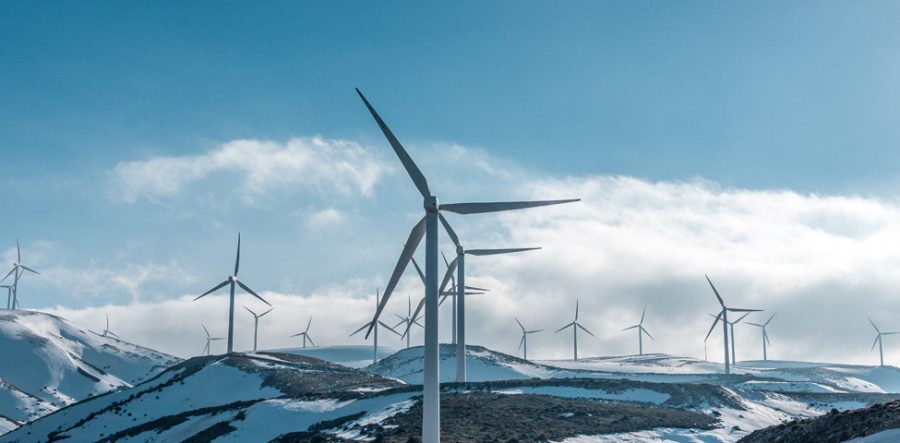 Maya Ormazabal
Maya Ormazabal
Head of Environment and Climate, Telefonica
Telefónica Energy and Climate change strategy
Telefónica has a strong strategy that integrates climate change and energy that is fully embedded in our business strategy. We are committed to reducing our carbon footprint, but, secondly and more significantly, we offer digital products and services which reduce our customers’ emissions.
Given its global nature, climate change is currently integrated into the management of the core aspects of the company, such as governance, risks (implementing TCFD recommendations), and setting ambitious targets. Part of the variable remuneration of the Board and all employees are associated with achieving these targets.
This climate change and energy strategy is part of Telefonica’s Responsible Business Plan, headed by the Board of Directors. For over ten years, we have had a Global Energy Efficiency and Climate Change Office, comprising global areas like Operations, Environment and Procurement, in charge of implementing the strategy aligned with our core business.
As a result, we were included for the fifth year in a row in the climate change CDP A-list and achieved our 2020 targets (validated by SBTi) two years in advance.
At COP25, we announced new challenging energy and emissions targets, aligned with the ambitions of the 1.5 degrees scenario, and validated by SBTi.
- Reduce our energy consumption per unit of data traffic by 85% in 2025
- Reach 85% of renewable electricity consumption in 2025 and 100% in 2030
- Halve our emissions in 2025, reduce by 70% in 2030 and become carbon neutral, meaning zero-net emissions in 2050
- Reduce 30% of emissions of our supply chain by 2025
- And avoid through products and services 10 tons of CO2 for everyone we produce by 2025
These targets help us to leverage decarbonisation opportunities, to be more competitive and to offer our customers the cleanest network. We reduced our carbon emissions while reducing operating costs through efficiency and renewable energy and growth while decarbonising the economy.
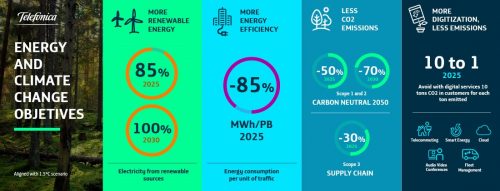
Figure 1: Energy and Climate Change Objectives
Introduction
Telefónica is one of the largest telecommunications companies in the world in terms of market capitalisation and number of customers. With its best in class mobile, fixed and broadband networks, and innovative portfolio of digital solutions, the company is transforming itself into a ‘Digital Telco’. Telefónica has a significant presence in 17 countries and a customer base of over 327 million accesses around the world. Telefónica has a strong presence in Spain, Europe and Latin America where the company focuses an important part of its growth strategy
Telefónica has made a solid commitment to sustainability and has a clear strategy in terms of energy efficiency and renewable energy. After the approval in 2015 of the global objectives of energy and climate change, Telefónica has become a lead operator contributing to the fight against climate change worldwide.
The global objectives now announced, include the commitment to reduce greenhouse gas emissions (GHG) by 50% in absolute terms by 2025, 70% by 2030 and become carbon neutral by 2050. In 3 years the company has reduced its carbon emissions by approximately 40%.
The main lever to articulate this change is Telefónica’s network transformation based on energy efficiency and a Renewable energy plan. Energy efficiency is a great challenge when we think about the exponential increase in digitalisation. But renewable sources are necessary to decarbonise Telefonica´s activity. The company is 100% renewable in Europe and Brazil nowadays, and more than 50% globally.
The Renewable Energy Plan contemplates different alternatives adapted to each country, purchase of guarantees of origin, renewable self-generation, or the signing of long-term purchase agreements with renewable energy generators.
We reduce our impact while helping other sectors and accompanying our customers in the decarbonisation process. Our services are becoming essential to reduce climate change and are showing encouraging results.
Overall, in 2018, we avoided through our services and products more emissions than our carbon footprint, having a net positive impact in the environment, but this could have an exponential increase in the future.
Business Imperative
Energy Efficiency Plan/ Renewable Energy Plan
Climate change is one of the most important challenges in society. The World Economic Forum identifies it as one of the greatest global risk factors. One of the main reasons is the intensive use of energy in the current economic model since it means more than two-thirds of the total global emissions. To limit the global temperature increase to a maximum of 1.5ºC is necessary to make an energy transition based on efficiency and renewable energy.
In 2010, to optimise the power consumption of Telefónica’s network, an Energy Efficiency Plan was compiled. To date, 740 projects have been implemented, spanning Telefónica’s entire operation. With an annual growth rate of 7%, thanks to the Global Energy Centre, created in 2015 to accelerate efficiency, managers have been responsible for encouraging energy efficiency projects from each country within the Telefónica Group.
Within nine years, more than 4,000 GWh, 553 million euros has been saved, and 1.27 million tonnes of CO2eq emissions avoided.
By 2018, 139 initiatives were implemented across Telefónica’s networks and offices. These initiatives have led to savings of 181 GWh and prevented over 73,145 tonnes of CO2eq emissions. Global initiatives have been to modernise the network, increasing its overall efficiency by replacing copper by fibre optic; renovation of power plants and HVAC equipment; utilising free air cooling with air directly from the outside; shutting down legacy networks; implementing power-saving features in the access network; reducing fuel consumption by implementing hybrid stations.
This effort has been reflected in a 64% improvement in energy intensity ratios (MWh/PB) when compared to 2015, and we decoupled the growth of our services from power consumption.
In 3 years data traffic in our networks has increased 176%, while the energy consumption has remained constant. Now we have committed to reducing the energy consumption by traffic 85% (MWh/PB) in 2025, compared with 2015.
Type of projects:
- Lighting: Replacement of fluorescent lights with LED technology and installation of presence detecting sensors.
- PSF (Power Saving Features): Activation of energy-saving functions during periods of low traffic in our base stations and centres.
- Cooling: Technological update of the cooling devices and the installation of free cooling facilities, especially in the base stations and centres.
- Power: Technological update for power units and substitution of poor efficiency rectifiers.
- Transformation of the Network: Shut down of old equipment, Network upgrades and location optimisation.
- Renewable self-generation: Implementation of renewable systems for self-consumption and reduction of fuel consumption.
- Others: Configuration of our network equipment to improve its efficiency.
- SMIP: Smart Energy in the UK. Smart Metering Implementation Plan
Renewable Energy Plan
Telefónica’s Renewable Energy Plan includes three action areas, depending on the markets in which they operate and the regulations in force in each one: acquisition of renewable energy with a guarantee of origin, long-term power purchase agreements (PPA), shorter duration and self-generation. 58% of the electricity that Telefónica consumes on a global level is now renewable and are committed to becoming 100% renewable by 2030.
Decarbonising the company demands only the maximum efficiency in energy usage, but also it comes from renewable resources. To do this, Telefónica’s Renewable Energy Plan sources 100% of their energy in Europe and 58% worldwide from zero-emission sources, meeting the targets set for 2020 in advance.
Similarly switching to clean energy also reduces operating cost and lessen the dependency on fluctuating fossil fuel prices. Telefónica’s Renewable Energy Plan projects 6% savings on energy OPEX by 2020 and could reach 26% by 2030.
- PPAs are the preferred course of action in Latin America, with Telefónica Mexico’s agreement to consume energy from the country’s largest solar park, KAIXO Solar, located in the state of Chihuahua, for 20 years. Representing 40% of its annual electricity consumption. In 2019 the subscription of new PPAs in other markets where the regulations are permitted, this, such as Argentina and Spain are planned
- Telefónica is 100% renewable in Germany, Brazil, Spain and the United Kingdom
- As for self-generation, Telefónica has gradually increased the number of base stations in the mobile network to more than 4,300 that operate on renewable energy. It also enables the avoidance of using fuel-powered generators in remote areas
In total, 3,382 GWh comes from renewable energy sources. This has enabled Telefónica to avoid emissions by 1 million tonnes of CO2. This demonstrates that renewable energy is the key to decarbonising activities and reducing carbon footprint in absolute terms.
EcoSmart Services
In an increasingly connected world, digitisation is an excellent lever for accelerating many of the changes required to halt climate change. Fibre and 5G will allow for double the speed and capacity of the network each year, reducing energy consumption as a result of efficiency and renewable energies. In this regard, digital technologies can help to reduce global carbon emissions by at least 15% by means of solutions for the energy, transport and construction sectors, among many others.
Telefónica’s greatest contribution to the environment is its digitalisation, reducing the company’s impact while helping other sectors and accompanying its customers in their own decarbonisation processes. For example, teleworking, fleet management services and solutions such as Smart Agro, Smart Lighting, and Smart Waste are making a positive contribution to curbing climate change by improving specific consumption metrics by between 15% and 85%.
As an example, providing customers with real-time information on their energy consumption to help control and manage energy usage, save money and reduce carbon emissions. Telefonica is currently managing meters in the most populated regions of the UK, representing 22 million buildings and 40 million meters.
- Fleet Management: Telemetry fleet of vehicles and management through IoT platforms provides instant information to drivers in 12 countries managing more than 207 thousand vehicles, allowing customers to save about 90minllion litres if the fuel
The Solution
Energy is an essential resource for the activity of telecom operators. Most of the energy consumption (95% in Telefónica) comes from operating our network, of which electricity consumption represents the majority (93% in Telefonica). So, energy efficiency and renewable sourcing are the key elements for reducing carbon emissions and at the same time, operating expenses, achieving a double win.
As a result of our integrated strategy, since 2015 we have been able to stabilise energy consumption (-0.29%, despite that the traffic managed by our networks increased by 176%) and at the same time, reduce our carbon emissions by 37%.
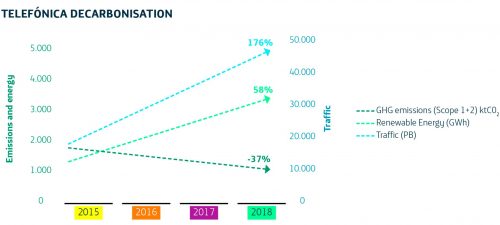
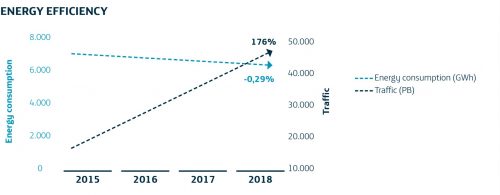
Figure 2: De-carbonisation and Energy efficiency 2015 – 2018
On the other hand, decarbonisation demands not only maximum energy efficiency but also moving electricity consumption to renewable sources. Telefónica has a Renewable Energy Plan, through which 100% of our electricity in Europe, Brazil and 58% worldwide, comes from renewable sources (achieving our 2020 target, 50%, two years in advance).
In addition, switching to clean energy also reduces our operating expenses and makes us less dependent on fluctuations in fossil fuel prices. Our Renewable Energy plan projects a 6% savings on energy OPEX by 2020 and could reach 26% in 2030. The Plan includes all types of solutions: self-generation, renewable energy purchasing supported by certificates (guarantees of origin, iREC) and long-term agreements (Power Purchase Agreements – PPA) and non-conventional renewable energy takes priority.
Telefónica’s emissions without our renewable energy plan would have been 80% higher.
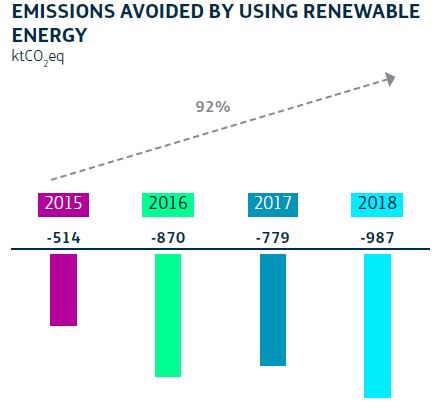
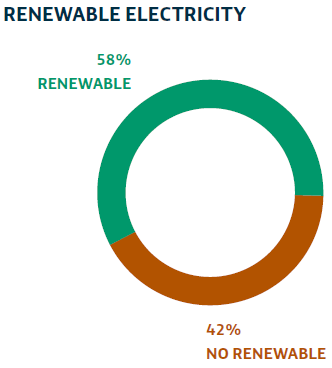
Figure 4: Percentage of Telefónica’s global electricity consumption
Digitalisation is not only a key lever for social progress but also is critical to decarbonising the global economy. It is a necessary tool to reduce emissions, and we must take advantage of the opportunities that it could bring to our planet.
Smart societies powered by digitalisation and virtualisation leveraged on network transformation are fundamental factors for the future development of climate. According to some studies, technology has the potential to reduce global emissions between 15% and 35% by 2030.
To reach our climate change ambition, we need exponential disruption in the economy, and digitalisation can make an important contribution by supporting all sectors of the economy such as transport, construction or energy, and promote sustainable habits among citizens.
In 2018 we avoided through our services 1.4 Million tCO2 similar to our own carbon footprint.
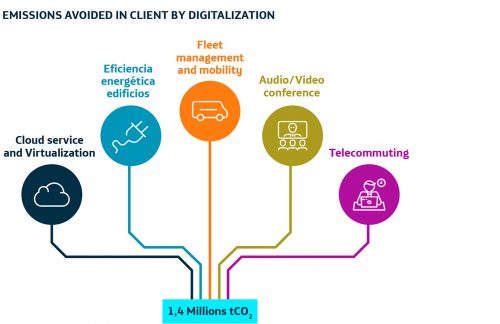
Economic Benefits
Our climate change strategy prepares Telefonica to face climate risks, physical and transitional. But moreover, it offers economic benefits in the short, medium and long term.
In 2019 Telefonica issued the first green bond of the industry with €1,000 million, that will be dedicated to the transformation of our fix network in Spain, migrating it from copper to fibre-optic to the home (FTTH). It will allow us to be – 85% more energy-efficient in customer access in a sustainable way, closing more than 300 buildings by compacting the network.
Integration of the strategy
Telefonica’s integrated strategy has achieved important goals, both internally and externally.
In 2016, we set up 2020 targets, validated by SBTi:
- 30% reduction in carbon emissions (scope 1+2)
- 50% of renewable electricity consumption
- 50% reduction in energy consumption per data traffic (MWh/PetaByte)
These targets were accomplished in 2018:
- 37% reduction in scope 1+2 emissions
- 58% of renewable electricity consumption
- 64% reduction in energy consumption per data traffic.
So, during 2019, new and even more ambitious targets have been established for 2025/2030/2050, aligned with 1.5 degrees scenario:
- Halve emissions by 2025, 70% reduction in carbon emissions(scope: 1+2) by 2030. Carbon neutrality by 2050.
- 50% reduction in carbon emissions (scope 1+2) and 70% by 2030.
- 30% reduction in Scope 3 supply chain emissions in 2025.
- 85% of renewable electricity consumption. 100% by 2030.
- 85% reduction in energy consumption per data traffic (MWh/PetaByte) by 2025.
Also, our digital services are a vital means to reach emissions reductions in our customers’ activity. Digitalisation and connectivity are the main instruments for dealing with the environmental challenges affecting society at large: climate change, water shortage, circular economy, pollution and loss of biodiversity. This new digital era is an opportunity for the process of transformation of the economy, business and society to be carried out while providing solutions to reduce the environmental impact. Many of our services now have this integrated approach. Our business strategy is committed to the digital revolution, which is why we provide services based on connectivity, Internet of Things (IoT), Cloud or Big Data. In all of these, we find environmental benefits; for example, with IoT services, we make more efficient use of resources such as energy and water, with Big Data we are helping to improve traffic planning and air quality, and with drone-based services and connectivity we can improve fire response.
Thanks to the IoT fleet management, energy building services, video/audio conferences, cloud and connectivity to promote teleworking, in 2018 we avoid the generation by our customers of 1.4 million of tons of CO2. Our services avoided 1.2 times the emissions that we generated, that is, for each ton that Telefónica emits in its activity, we can prevent 1.2 tons in our customers.
Our objective is to generate a more significant positive impact: in 2025, for each ton of CO2 emitted by Telefónica, we will avoid 10 tons of CO2 into the atmosphere through our services.
Challenges and Lessons learned
The complete life cycle of Digitalisation has a great positive influence on climate change, but we need it to do it in the right way, containing energy consumption, using renewable sources and promoting sustainable innovation.
Elevating climate strategy in the company and involving critical areas offer great opportunities.
Conclusion
Telefónica supports the creation of a world where digital technology contributes to protecting the planet. Telefónica’s solid commitment to sustainability and a clear strategy in terms of energy efficiency and renewable energy has contributed to the decarbonisation of the economy and the reduction of its own impact and the increase of digitalisation as an enabler of carbon reductions in many sectors, like transport, industry or cities.
In conclusion, Telefonica’s Energy Efficiency Plan has im[pleneted 139 initiatives across Telefónica’s networks and offices. These initiatives have led to savings of 181 GWh and prevented over 73,145 tonnes of CO2eq emissions. Global initiatives have been to modernise the network, increasing its overall efficiency by replacing copper with fibre optic; renovation of power plants and HVAC equipment; utilising free air cooling with air directly from the outside; shutting down legacy networks; implementing power-saving features in the access network, and reducing fuel consumption by implementing hybrid stations.
The Renewable Energy Plan, through which 100% of Telefónica’s electricity in Europe, Brazil and 58% worldwide, now comes from renewable sources. Achieving the 2020 target of 50%, two years in advance.
and finally, the EcoSmart Services which includes a huge variety of projects with significant operational and maintenance saving potential, such as:
- Fleet management and mobility (Telemetry fleet of vehicles and management through IoT platforms
- Audio / Video conference
- Telecommuting
- Cloud service and Virtualisation.
Read more at:
https://www.telefonica.com/en/web/responsible-business/environment/energy-and-climate-change-2
https://www.telefonica.com/en/web/responsible-business/environment/green-ict
